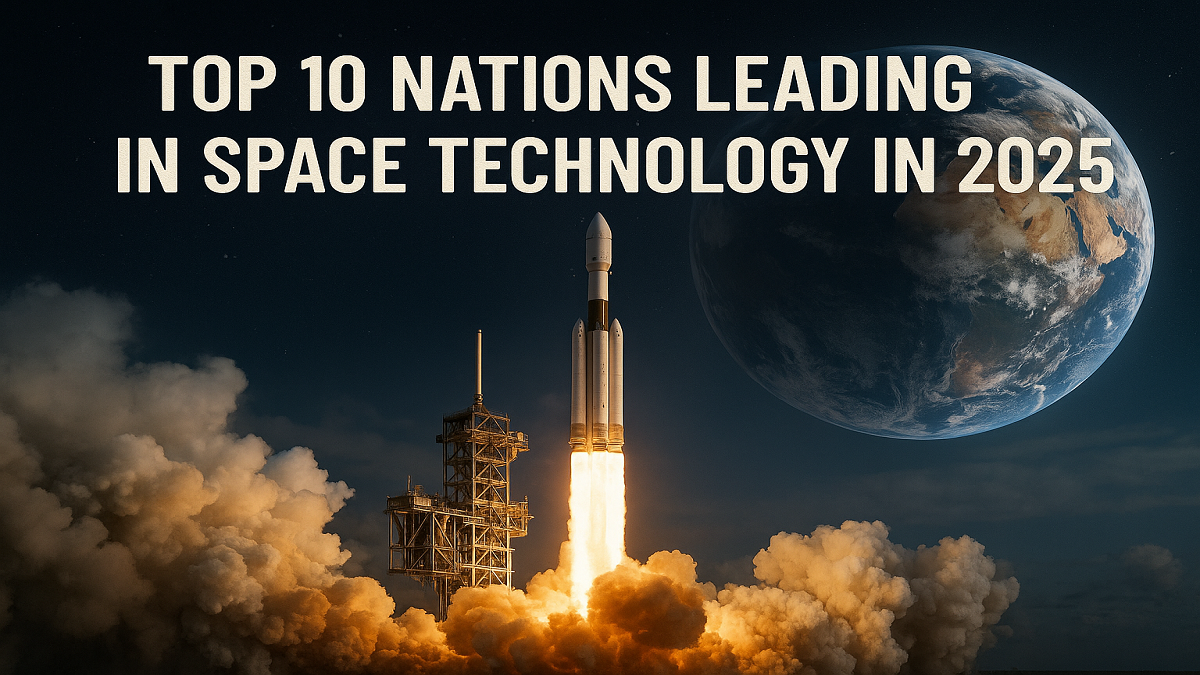In 2025, the race for space supremacy is no longer confined to Cold War rivals. A new era of multi-polar space leadership is being shaped by countries investing heavily in launch systems, satellite infrastructure, deep space exploration, and commercial space ecosystems. Space is no longer just a frontier—it’s a platform for strategic dominance, economic growth, and technological prestige.
This article ranks the top 10 countries leading in space technology in 2025, highlighting their unique contributions, missions, and emerging space industries.
Top 10 Spacefaring Nations in 2025
| Rank | Country | Key Strengths | Notable Achievements |
|---|---|---|---|
| 1 | United States | Human spaceflight, reusability, deep space missions | Artemis, Starlink, Mars rovers |
| 2 | China | Moon & Mars exploration, space station, ASAT tech | Tiangong, Tianwen-1, Chang’e series |
| 3 | Russia | Heritage systems, heavy launch, lunar ambitions | Soyuz, GLONASS, Oryol |
| 4 | India | Affordable launch, lunar missions, private sector growth | Chandrayaan-3, Gaganyaan, Aditya-L1 |
| 5 | European Union (ESA) | Earth observation, deep-space science, launch collaboration | Ariane 6, JUICE, Copernicus |
| 6 | Japan | Planetary probes, ISS partner, lunar plans | Hayabusa2, Martian moons mission |
| 7 | UAE | Mars mission, Moon rover, regional diplomacy | Hope Probe, Rashid, MBRSC |
| 8 | South Korea | Launch vehicles, lunar orbiters, satellite tech | KPLO, Nuri rocket, 6G satellites |
| 9 | Iran | Military satellites, domestic launch capability | Noor-2, Qased, Simorgh |
| 10 | Brazil | Satellite applications, equatorial launch site | Amazon monitoring, Alcântara Launch Center |
1. United States: Unmatched Leader in Space Exploration and Innovation
The United States remains the global leader in space technology in 2025, with unmatched capabilities across government, military, and commercial sectors.
Government and Civil Space Leadership
NASA continues to lead in planetary science, Mars exploration, and Artemis Moon missions, with Artemis III preparing for the first human landing since Apollo. The James Webb Space Telescope has revolutionized astrophysics.
Commercial Space Dominance
The U.S. dominates commercial space through SpaceX, Blue Origin, Rocket Lab, and Sierra Space. Reusable launch vehicles, mega-constellations (Starlink), and plans for private space stations give the U.S. a unique edge.
Defense Space Capabilities
The U.S. Space Force continues to expand its role in satellite defense, space-based ISR, and anti-satellite resilience, making the country the most space-capable nation by far.
2. China: Rapid Expansion and Strategic Ambitions
China has emerged as the United States’ closest space competitor, executing an ambitious space program with increasing autonomy and global ambition.
National Space Strategy
Led by CNSA (China National Space Administration), China has launched its own modular space station—Tiangong, successfully landed rovers on the Moon (Chang’e missions) and Mars (Tianwen-1), and is planning a Moon base with Russia.
Military and Commercial Integration
China integrates civil, military, and commercial efforts under state direction. It has developed its own GNSS system (BeiDou), and state-backed firms like CASIC and i-Space are advancing in launch and satellite services.
3. Russia: Legacy Power with Deep-Space Focus
Despite economic challenges, Russia remains a major space power due to its extensive heritage in launch vehicles, ISS operations, and deep-space missions.
Technological Backbone
Russia’s Soyuz, Proton, and Angara rockets continue to serve global markets. New efforts include the Oryol crewed spacecraft, Moon missions, and future participation in a BRICS-led space station.
Strategic Influence
Roscosmos maintains strong cooperation with countries like India, Iran, Venezuela, and China, leveraging its heritage and GLONASS satellite system to maintain global relevance.
4. India: Precision, Pragmatism, and Progress
In 2025, India stands out as a rising force in space through ISRO (Indian Space Research Organisation) and its expanding private space sector.
Scientific and Operational Excellence
India launched its Chandrayaan-3 Moon lander and Aditya-L1 solar observatory successfully, and has planned the Gaganyaan crewed mission. It maintains an efficient and cost-effective launch program with PSLV and GSLV rockets.
Commercial Growth
With the rise of Skyroot Aerospace, Agnikul Cosmos, and Dhruva Space, India’s NewSpace ecosystem is growing rapidly, contributing to satellite manufacturing, launch services, and space analytics.
5. European Union (ESA Members): Collaborative Technological Leadership
While not a single country, the European Space Agency (ESA) represents the combined capabilities of major European nations like France, Germany, Italy, and Spain, making Europe a formidable space force.
Multi-national Coordination
ESA continues to develop and operate Ariane 6 launchers, Copernicus Earth observation satellites, and deep-space probes like JUICE to study Jupiter’s moons.
Member Nation Strength
France’s CNES leads in satellite technology; Germany excels in scientific instruments and rover development; Italy contributes to ISS modules and robotics.
6. Japan: Deep-Space and Asteroid Exploration Pioneer
Japan is known for its high-impact contributions to space science and planetary exploration. The Japan Aerospace Exploration Agency (JAXA) focuses on sample-return missions, deep-space research, and ISS collaboration.
Asteroid Missions and Innovation
Japan’s Hayabusa2 was the first to retrieve and return asteroid samples, and future missions will study Martian moons and interplanetary particles. It also plays a crucial role in the Artemis lunar program.
Commercial Launch Progress
Japanese companies like Interstellar Technologies and IHI Aerospace are growing in the small satellite launch market.
7. United Arab Emirates (UAE): Ambitious and Accelerating
The UAE has emerged as the Arab world’s space pioneer, demonstrating strong achievements in Mars exploration, satellite development, and space diplomacy.
Key Missions
The UAE’s Hope Probe became the first Arab spacecraft to orbit Mars. The nation has also launched the Rashid Moon rover and is working toward a crew mission by the 2030s.
Long-Term Vision
Backed by the Mohammed bin Rashid Space Centre (MBRSC), the UAE is investing in STEM education, Mars colonization plans, and regional cooperation.
8. South Korea: Emerging Commercial and Government Space Force
South Korea has made major strides in space launch systems, satellite technology, and lunar research. It has developed its own Nuri rocket, successfully launched in 2022 and upgraded since.
Satellite and Moon Ambitions
With the Korea Pathfinder Lunar Orbiter (KPLO), South Korea joined elite lunar exploration nations. The country also excels in defense satellites, space weather monitoring, and precision navigation.
Private Sector Growth
Companies like Hanwha Aerospace and INNOSPACE are investing in reusable rockets and nanosatellite services.
9. Iran: Regional Military and Civilian Space Aspirations
Despite sanctions, Iran continues to develop indigenous launch vehicles, reconnaissance satellites, and military space programs.
Strategic Assets
Iran has successfully launched satellites like Noor-2, and its military space command oversees operations linked to intelligence gathering and deterrence. The Qased and Simorgh rockets form the backbone of its orbital ambitions.
Self-Reliance Focus
Iran’s space program emphasizes indigenous development, often linked to its ballistic missile and aerospace industries.
10. Brazil: Latin America’s Space Leader
Brazil leads Latin America in space technology, with operational satellite programs and a growing interest in launch services from the Alcântara Launch Center.
Civilian and Commercial Growth
Brazil operates under AEB (Brazilian Space Agency) and partners with nations like the U.S., Israel, and India. Its satellite programs support agriculture, Amazon monitoring, and communications.
Future Potential
Brazil is poised to become a regional hub for small satellite launches, with international companies eyeing equatorial launch advantages.



 ISRO Projects Seven Launches Including U...
ISRO Projects Seven Launches Including U...
 Google Unveils Project Suncatcher to Dev...
Google Unveils Project Suncatcher to Dev...
 AIIMS Delhi Conducts India’s First Dedic...
AIIMS Delhi Conducts India’s First Dedic...







